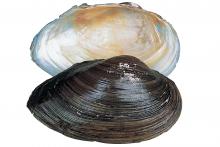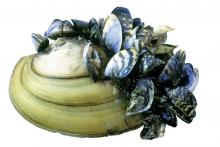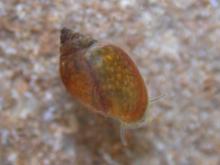Aquatic Invertebrates
Media

Species Types
Scientific Name
Pygandon grandis
Description
When a floater dies, this large mussel with a thick shell will actually rise to the water surface and float as it decays.
Media

Species Types
Scientific Name
Toxolasma parvus
Description
These diminutive mollusks are the smallest of Missouri’s freshwater mussels.
Media

Species Types
Scientific Name
Tritogonia verrucosa
Description
Shaped like a checkered gunstock, with its unique, turned-down edge, pistolgrips are easy to identify.
Media

Species Types
Scientific Name
Amblema plicata
Description
Sometimes called the blue-point, this mussel species is widely distributed in Missouri rivers and is occasionally found along reservoir margins.
Media

Species Types
Scientific Name
Lasmigona complanata
Description
The shell of this mollusk is large and impressive in overall size. Although fairly flat, it can be more than 8 inches long. A large wing on the heelsplitter can be painful if you step on it.
Media

Species Types
Scientific Name
Potamilus purpuratus
Description
Like the pink heelsplitter and fragile and pink papershells, the bluefer uses freshwater drum as a host.
Media

Species Types
Scientific Name
Bivalve molluscs in order Unionoida
Description
Secretive and seldom seen, freshwater mussels are extraordinarily diverse in Missouri. We have nearly 70 species within our borders. Many are declining, and several are endangered.
Media

Species Types
Scientific Name
Dreissena polymorpha
Description
Zebra mussels are named for their shells, which have alternating light and dark bands. They are a highly invasive nonnative species. Learn how to prevent their spread.
Media

Species Types
Scientific Name
Over 20 Missouri species in former subclass Prosobranchia
Description
Gilled snails are one of two main groups of aquatic snails in Missouri (the other group is the "lunged" snails). Gilled snails, or prosobranchs, breathe with gills and possess a hard trapdoor-like operculum. They are most common in the Ozarks.
Media

Species Types
Scientific Name
Over 30 Missouri species in former subclass Pulmonata
Description
Pulmonate, or lunged snails breathe via a lunglike pulmonary cavity, and they lack the hard trapdoor-like operculum found in gilled snails. Except for in the Ozarks, pulmonate snails predominate in most of the aquatic regions in our state.
See Also
About Aquatic Invertebrates in Missouri
Missouri's streams, lakes, and other aquatic habitats hold thousands of kinds of invertebrates — worms, freshwater mussels, snails, crayfish, insects, and other animals without backbones. These creatures are vital links in the aquatic food chain, and their presence and numbers tell us a lot about water quality.





















